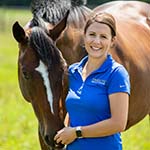“What can I feed to make my horse less hot?” is one of the top five most commonly asked questions from horse owners.
Understandably so, a horse that is hot, hyperactive, or simply more reactive to the world around them can be more challenging to find success with in the show ring and can be more dangerous to handle on a day to day basis.
Nutritional Factors That Contribute to Horse Hyperactivity
Since this is such a common question there are a lot of misperceptions on nutritional factors that can contribute to horse hyperactivity as well as ways to change the diet in an attempt to fix this.
A long-running misperception is that protein causes a horse to be hot, in fact I have had more than one person tell me they could not go from a 10% protein concentrate to a 12% protein concentrate because they were worried it would make their horse too hot. But if we do the math on this you can see how little an increase in percentage protein changes total dietary protein intake.
6 lb concentrate x 10% protein = 272 grams of protein 6 lb concentrate x 12% protein = 327 grams of protein
An increase in 2% protein in the concentrate increased protein intake by 55 grams per day. For context, feeding 20 lb per day of a moderate quality grass hay with 13% crude protein will provide 1,180 grams of protein to the horse’s diet.
The myth that protein makes horses hot is often attributed to the increase in hyperactivity observed in some horses when they are switched from a primarily grass hay to a primarily alfalfa or other legume hay. While the average alfalfa will be higher in protein than grass hay, alfalfa is also higher in energy. A sudden increase in energy without a change in activity level can leave horses with extra energy to cause mischief. This increase in energy is the same reason that adding alfalfa to the diet of the hard keeper helps horses keep weight without increasing the amount fed.
How NSC Can Cause Horses to Become Hyperactive?
While protein has gotten a bad rap, it is actually the non-structural carbohydrates (NSC) in a feed that can cause some horses to be hyperactive. Non-structural carbohydrates are comprised of starch and sugar and it is important to look at both, as starch and sugar are absorbed and metabolized in the same way and have the same effect on the horse’s behavior. A feed can be marketed as “low starch” but also be high in sugar. Non-structural carbohydrates are a source of rapid-release energy that cause dramatic swings in hormones after a meal which can predispose horses to hot behavior.
Beyond the immediate hormonal responses, high NSC diets increase risk of ulcers and other digestive upset and pain from these issues can cause unpredictable behavior in the horse that in some cases is interpreted as hyperactivity.
To replace the energy from NSC, we would look towards diets that provide more energy from fat and highly digestible fiber which are both cooler sources of energy. A diet with zero NSC simply does not exist. With the exception of ingredients that are comprised of 100% fat (like an oil), there will be NSC in all feedstuffs. In fact, the number one source of NSC in most horse’s diet is their forage. It is important to remember that while we do not want to feed large amounts, NSC remains an important component of the diet as there are some functions in the body that can only use sugars for energy.
When comparing feeds, we need to keep both the percent NSC and the daily feeding rate in mind as it is ultimately the amount of NSC consumed per meal that matters. A feed that is higher fat will provide more calories and allow for a lower feeding rate while still maintaining body condition, which may offset a slightly higher percent NSC as compared to another feed.
Feed B, 10% fat: 6 lb per day at 16.5% NSC = 450 grams NSC
A common mistake is to get so caught up in decreasing dietary NSC that the balance of the total diet is overlooked. Don’t forget that we still need to meet the horse’s requirements for amino acids, vitamins and minerals and also provide them with enough energy to maintain body condition and perform; a skinny horse may be a calm horse but it is not a healthy one.
Conclusion
Ultimately, nutrition is only one component of many that contribute to horse hyperactivity. In feeding a diet that is low NSC, we are removing the contribution that diet may have towards hyperactivity but this is not guaranteed to make a packer out of a naturally high-strung horse. At a certain point you have to accept that the level of activity from the horse is what you have to work with and decide if it is the right horse for your program and discipline.

